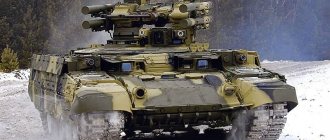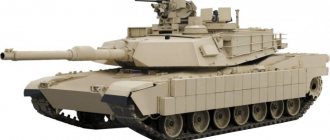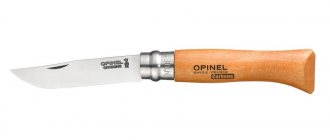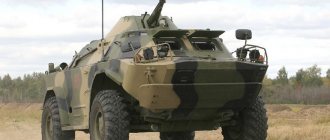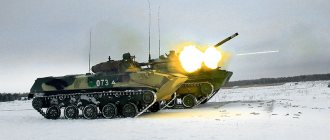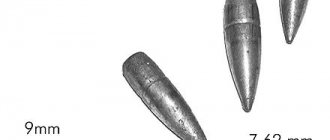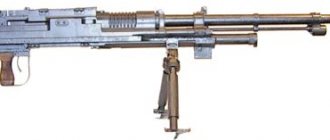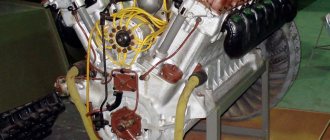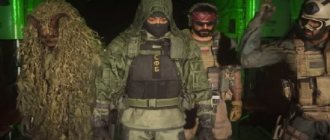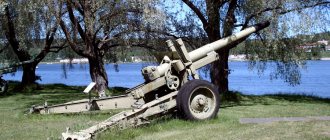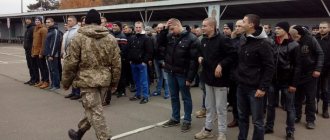Direct fire
The Syrian experience of using armored vehicles armed with 30-mm automatic cannons has shown that standardization of caliber, regardless of the type of military equipment, does not always lead to the expected results when performing combat missions. During the battles for Aleppo and other large populated areas, controversial results of hits from 30-mm high-explosive fragmentation shells from 2A42 automatic guns were repeatedly recorded, which did not cause significant damage to the infrastructure prepared by the enemy. This approach did not make it possible to take advantage of the main advantage during ground operations - surprise when storming fortified positions, to destroy which it was ultimately necessary to bring in tanks with 125-mm guns.
BMPT_1
BMPT "Terminator-2" in Syria
Photo: twitter.com/WaelHussaini
Sending a tank support combat vehicle to the most dangerous areas in this sense became a landmark decision, after which many questions regarding the use of equipment with a certain type of weapon disappeared by themselves. Izvestia’s source in the defense industry noted that, given the insufficient effectiveness of 30-mm automatic cannons, fortified enemy targets were hit exclusively by ATGM launches, which made it possible to solve the problem of ground groups advancing with one vehicle.
"Armata" will become a super tank killer
New Russian vehicles will be equipped with long-range, high-precision anti-tank systems
It should be noted that in Syria another decision related to the protection of not only the crew, but also the ammunition, was finally confirmed. We are talking about protective screens for ATGM launchers, the design of which was proposed by specialists from the (still Soviet) ChTZ in the late 80s. Tests of the vehicle in combat have shown that such protection has obvious advantages compared to ATGMs placed on open guides. Ultimately, the new BMPT may feature fully enclosed bulletproof containers for anti-tank missiles with folding “curtains” or a front cover.
History of development and generation of tanks
Tank "Armata"
The history of the development of the Armata platform and tank is associated with the rivalry between the USA and the USSR in the creation of vehicles with an uninhabited turret. The first drawings of such projects began to be developed in the 1980s. Later they were continued by several developments - objects 195, 640 and 299.
Despite the economic difficulties of the 90s, the Russian designer managed to create the first tank focused on conducting network-centric warfare. The development was based on the creation of the Armata universal combat platform, work on which has been carried out since 2009.
For its design, the developments of previous experimental tanks and combat vehicles were used. The peculiarity of the new platform was its wide range of applications. The modular system made it possible to supplement it with the necessary weapons in accordance with the specifics of the order.
This arrangement provided the crew with additional protection. This aspect solves two problems at the same time - it increases the efficiency of the crew, who feel their “invulnerability” and protects trained professionals, whose value has become equal to the cost of the tank itself.
Also, when developing the Armata tank, the increased importance of infantry formations armed with modern anti-tank missile systems was taken into account. In this context, the concept of a single tank is considered obsolete. In the new concept of combat, the emphasis is placed on tactical units of several combat vehicles.
Taking this factor into account, the universal platform “Armata” was created. The T-14 developed on its basis performs the function of reconnaissance and coordination of actions with other tactical level vehicles. This does not reduce the combat characteristics of the tank, but it changes the conditions for its use in battle.
I have contact
In the summer of 2020, the first plans for new R&D on the topic of tank support combat vehicles were officially announced. Industrial director of the Armaments cluster of the Rostec corporation, Sergei Abramov, said that UVZ specialists have begun to develop the design of the future vehicle, which (and this is important) will be created taking into account the experience of combat use.
At the same time, the appearance of the third “Terminator” has not been a secret for a long time - the model, which, most likely, will be most similar to the first prototype of the third version of the BMPT, was presented at the stand at the Army-2018 forum. It is worth noting that instead of maximizing deep modifications to the existing (massive and extremely cheap) chassis, UVZ focused on creating a completely different type of vehicle.
In this sense, the choice of the heavy unified tracked platform "Armata" seems one hundred percent justified. It should be remembered that the key complaints regarding the previous generation BMPT were made specifically to the chassis. The T-72/90 platform, although it has won the title of one of the most reliable in the entire history of tank building, still has limitations in its modernization potential that do not allow it to realize the capabilities of promising combat modules.
BMPT_2
Uninhabited combat module "Boomerang-BM" with a 30-mm 2A42 cannon, installed on a T-15 infantry fighting vehicle
Photo: commons.wikimedia.org/Vitaly V. Kuzmin
It is worth noting that when choosing the Armata platform as the next stage for the BMPT, the developers laid down both the principle of maximum automation of the battle control process and the maximum possible efficiency of new types of ammunition and guns of other calibers. Long before the Syrian campaign of the Russian Armed Forces (and even long before the first and second campaigns in Chechnya), it became obvious that the weakest element in the firepower of Soviet armored vehicles were 30-mm automatic cannons, the shortcomings of which became increasingly apparent on combat vehicles.
Armored forum: what to expect from NATO combat vehicles
Main results of the annual conference IAV-2019, dedicated to the development and use of armored vehicles
Of course, this is well understood both in the GABTU (main armored department), and in the Ground Forces, and in the Ministry of Defense as a whole. In simple terms, this means that a completely different combat module with an automatic 57-mm gun was prepared for the BMPT version 3.0. It will eliminate the shortcomings of the Boomerang-BM module, which is quite suitable for combat work (but on different equipment and for other tasks) - one of the most modern versions of the combat vehicle with a 30-mm cannon, with which heavy T-15 infantry fighting vehicles on the Armata platform were first shown to the public four years ago.
Armament
Performance characteristics of the "Almata" and its weapons
Despite the concept of using the T-14 for reconnaissance and coordination of a tank unit, the Armata's own weapons correspond to the parameters of the main battle tank. The following aspects are highlighted in this issue:
- 125 mm gun 2A82-1M;
- machine guns "Kord" and PKTM.
The guns and machine guns are guided by a fire control system (FCS). The ballistic computer makes the necessary calculations using the following parameters:
- determining the tank’s own position using the GLONASS receiver and inertial navigation system;
- gyroscopic calculation of the tank’s position based on its angular orientation in space;
- calculation of wind direction and speed;
- determination of air temperature and humidity;
- taking into account barrel curvature during heating.
Smoothbore 125 mm gun 2A82-1M
Armata tanks are equipped with 2A82-1M smoothbore guns with a caliber of 125 mm. Their range is 7 km, rate of fire is 10-12 rounds per minute. In terms of technical characteristics, such guns are superior to the best NATO tank guns by 17% in muzzle energy and 20% in accuracy.
The supply of ammunition is automatic. It is possible to load the gun with projectiles a meter long, which allows the use of high-power sub-caliber armor-piercing ammunition. The gun's total ammunition capacity is 45 rounds, but its staffing has not yet been approved.
If necessary, 2A83 guns of 152 mm caliber can be installed on Armata tanks. This weapon has the ability to penetrate armor equivalent to up to 1000 mm, which significantly exceeds the protection of modern NATO tanks. Given the power of such a gun, there is no need for armor-piercing shells - the kinetic energy of the fired ammunition is enough to tear off the entire turret of any tank.
Taking into account this factor, the installation of these guns is still considered inappropriate. This makes the T-14 upgradeable if necessary to enhance the firepower of a tank unit. The probable reduction in the ammunition capacity of the new gun is also taken into account - to increase it it is planned to use a turret niche.
Reflex-M missiles
In addition to standard tank shells, the T-14 can hit targets with Reflex-M solid-fuel anti-tank guided missiles. They are capable of hitting almost any highly protected surface, ground and low-flying targets.
The charging of these missiles is carried out according to a tandem scheme. The leading part is designed to overcome the dynamic protection of the target. The main charge is aimed at penetrating armor and directly defeating vehicles or pillboxes. The projectile's flight path is a helical line.
PKTM machine gun
The Kalashnikov tank modernized machine gun (PKTM) on the T-14 is paired with a gun. Caliber - 7.62 mm. There is no information yet about the ammunition load. Designed primarily to engage infantry and lightly armored targets.
Machine gun "Kord" for destroying enemy shells and missiles
The Kord machine gun serves as an anti-aircraft installation for the tank and its air defense. Integrated with active tank protection. It has its own robotic turret, thermal imagers and AFAR radar, thanks to which it is capable of hitting even high-speed targets at a distance of 1.5 kilometers. Designed primarily to destroy shells and missiles.
Curb weight
A key dispute among experts erupted around the mock-up of a double-barreled artillery mount, shown at the Army-2018 forum. In a conversation with an Izvestia correspondent, independent military expert Alexei Khlopotov noted that at the moment it is difficult to make an unambiguous conclusion about whether there is any point in a twin artillery mount of 57-mm cannons, although such a scheme has a number of advantages.
“First of all, we are talking about the fact that such a machine will solve several problems simultaneously. In addition to the difficulties in effectively defeating the enemy in Syria, for example, several other problems were revealed. These include the defeat of small-sized UAVs, which are too expensive to fire with anti-aircraft guided missiles, and the use of artillery systems is not always effective,” Khlopotov noted.
According to the expert, the problem can be solved by a significant expansion of the range of ammunition that the new Terminator will be able to fire, depending on the nature of the combat operations and the type of target. It was just such a vehicle, equipped with the Kinzhal combat module (57 mm + Ataka ATGM), that was shown at the Army 2018 forum.
BMPT_3
Heavy infantry fighting vehicle T-15 on the Armata platform with a 57-mm cannon at the exhibition of the IV International Military-Technical Forum "Army-2018"
Photo: commons.wikimedia.org
According to Khlopotov, when developing such technology, it is necessary to maintain a subtle balance that will allow it to operate in any environment.
“The double-barreled version significantly outperforms the classic version in terms of use against UAVs, but the use of such equipment as part of fire support for ground units seems redundant,” Khlopotov noted.
With a light tank: the old class of armored vehicles is returning to the armies of the world
Why is this program so important?
Other requirements were also presented to the promising vehicle. According to some information, the customer’s technical specifications involve the placement of a target tracking machine, and the control system may include a device for detecting enemy optical means.
In addition, taking into account actions in difficult meteorological conditions, at the level of technical specifications, the issue of introducing an radar channel was worked out, which, among other things, turned out to be necessary for working by air and in conditions of poor optical visibility and IR interference. Such a solution can be implemented on a new element base - the first version of the combined guidance system was implemented in the Chrysanthemum ATGM and made it possible to fire in any weather conditions, day and night. Most of what the military requested, as in the defense industry, has either already been implemented or is in the final stages of development.
Advantages and disadvantages
The T-14 integrates many innovative developments and technologies.
Taking into account the design and performance characteristics of the T-14, the following advantages of the new tank are highlighted:
- crew protection, improved protection of the vehicle itself and its components;
- high firepower, firing accuracy;
- high speed and smooth ride on rough terrain, taking into account how much the tank weighs;
- invisibility of the machine for various detection methods;
- high range of detection and destruction of targets;
- a resource for further modernization of the tank, including increasing firepower.
Many characteristics and indicators remain unconfirmed or classified. However, the available data confirms the exceptional position of the Armata among modern tanks
At the same time, they also pay attention to the shortcomings of the T-14
Another disadvantage is the cost of a new tank. Even in mass production, its assembly costs about 250-350 million rubles, which casts doubt on the mass production of such tanks for the army, as well as the likelihood of their production for export.
Despite the inconsistency and inaccuracy of a number of aspects, the project is assessed positively. Western military analysts point to the design understanding of Russian developers of the modern concept of combat operations. The creation of the Armata demonstrates a transition from the quantity of equipment used to the quality combat capability of small tactical groups.
Possible types of ammunition
The ammunition load will include standard high-explosive fragmentation, sub-caliber and cumulative shells. It is assumed that it will be possible to fire guided surface-to-surface and surface-to-air missiles with automatic guidance.
Actually, the new Armata tank, the photo of which we attach to the article, is not a tank. In fact, this is a full-fledged multifunctional attack vehicle that can fight against enemy infantry, tanks, artillery and even enemy helicopters. Purely theoretically, it is also possible to fight stormtroopers.
Active protection
The highlight of the new tank is the KAZ "Afganit". This active protection system allows you to fight anti-tank missiles and grenades, even at extremely short distances (no more than 15-20 meters from the vehicle). The system was developed at Kolomenskoye KBM. It is known that it can intercept projectiles flying at a speed of 1700 m/s. In addition, a special shock core patented in our country will probably be used. Pointing it at the target is automatic and does not require operator confirmation.
When it all started
In 2010, news came from the Ministry of Defense that work on the Object 195 project had been completely stopped. The ministry considered that the T-95 tank, which was developed under this designation, almost completely replicates the T-90 MBT, and therefore is not very needed by the troops. But the designers were given another task: to create a completely new tank, built on different principles.
The terms of reference stated that the Armata complex was to be fully ready for mass production no later than 2015.
Armor characteristics
There was also a completely new armor. Fortunately, our defense industry has always had excellent capabilities in this area, so the development of new armor was carried out in the shortest possible time.
Most likely, the Armata platform will use armor steel grade 44S-sv-Sh, which has special strength characteristics. This material was created at OJSC Research Institute of Steel. Its key feature is its extremely low weight. This will not only make it possible to lighten the weight of the vehicle, begin to create relatively light and protected infantry fighting vehicles on the same platform, but also significantly increase the volume of internal space (more ammunition, crew comfort).
Detection Tools
According to some information, almost the same radar equipment will be on board as on the newest PAK T-50 fighter. In particular, the new Armata tank (the photo confirms this) will receive radars operating in the spacecraft range (26.5-40 GHz), created using an active phased array (AFAR). This is a unique development, in the production of which special ceramics are used.
Proposed layout
Let us emphasize once again that the main goal for which the Armata complex is being created is to obtain extremely unified vehicles. Moreover, standardization should concern not only the weapons used, but also the suspension and other technological design elements. Even the Americans don’t have anything like this in their troops (one should hope that we will actually have it).
It seems to be known for sure that there are two main layout options in the plans: with a rear and a front engine-transmission compartment. The suspension will probably be assembled on six rollers, the shock absorbers will be of the vane type, the turning mechanism will be differential, and the transmission will be hydrostatic. The gearbox is fully automatic, 12 steps. Most likely, it will be possible to switch stages manually.
Abrams M1A2
The basis of the US battle tank. The latest production modification is the M1A2 SEP V2. The mass of the tank in this modification is 63 tons; the vehicle uses an AGT-1500 gas turbine power plant with a power of 1500 hp. The tank's gun is represented by a 120-mm M256 smoothbore gun (a licensed version of the German Rheinmetall Rh-120 gun), has a modern fire control system and other electronics.
M1A2 Abrams
In comparative tests, it showed superiority over Leopard 2 in night shooting, but was inferior in daytime shooting. The M829A3 shells used by the tank have the greatest penetration among analogues. It is possible to install special dynamic protection for urban combat TUSK. The frontal armor uses depleted uranium, which both enhances the armor but is harmful to the crew. Despite its high cost, the tank has quite a few disadvantages - a weak chassis, a vulnerable external auxiliary power unit, a large tank profile, and a far from the best aimed firing range. The vehicle seemed to perform ideally in the US Iraqi campaigns, but in the conditions of a relatively equal battle against ISIS forces, the Iraqi Armed Forces lost many “Americans”.
Chassis and engine of Almaty
The new Armata medium tank is equipped with a 12-cylinder four-stroke X-shaped turbocharged diesel engine A-85-3A (12N360) with a power of 1,500 horsepower. The 12N360 multi-fuel engine, with direct injection, was developed by the Chelyabinsk Transdiesel design bureau and is produced at ChTZ (Chelyabinsk Tractor Plant).
The tank has a 7-roller active suspension on vane shock absorbers with a differential steering mechanism with hydrostatic transmission. The new active suspension eliminates the swaying of the tank while moving, which makes it possible to reduce the time of target acquisition by optical-electronic guidance means by 2.2 times, reducing the time of hitting a “tank” type target by 1.45 times!
The T-14 Armata is equipped with a tank information and control system (TIUS), which monitors all components and assemblies, controls on-board systems, and diagnoses faults, which allows the driver to control the engine and chassis without leaving the armored capsule for inspection and diagnostics - the need for repairs is determined electronics.
In the T-14, the design of additional fuel tanks was changed; for the first time for Soviet and Russian tanks, they became non-removable and recessed behind the armor and anti-cumulative shield. In this case, the tanks participate in additional protection of the engine, taking on shock deformations. The exhaust of Almaty engines is produced through pipes running through additional fuel tanks, which, taking into account the high heat capacity of hundreds of liters of fuel, reduces the visibility of the tank in the infrared range.
Although the new tank is being created according to all the standards of Russian tank building and is quite often compared to the “Black Eagle”, the model is an absolute novelty that has no analogues
An important distinctive feature is the development of a high level of crew safety, which will be placed in a special armored capsule
Photo of Almaty from the Victory Parade on May 9, 2020 in Moscow:
Increasing vehicle survivability on the battlefield
In addition, the new Armata vehicle (you will find a photo in this material) will have dramatically increased survivability due to the placement of shells in a special capsule, separate from the habitable compartment of the tank. Theoretically, in the event of being hit by an enemy shell or an anti-tank cumulative grenade, the detonation of the ammunition should not lead to the death of the crew.
Initially, this idea was included in the “Object 195”, also known as T-95/T-99. "Armata" will presumably also have the ability to accommodate the crew in a fully insulated capsule made of particularly strong alloys. The designers included in the design of this vehicle completely remote control, in which the tank crews would not have to appear outside the vehicle at all. In this regard, the Armata platform is completely unique. No matter how hackneyed and banal it may sound, there really are no analogues abroad.
